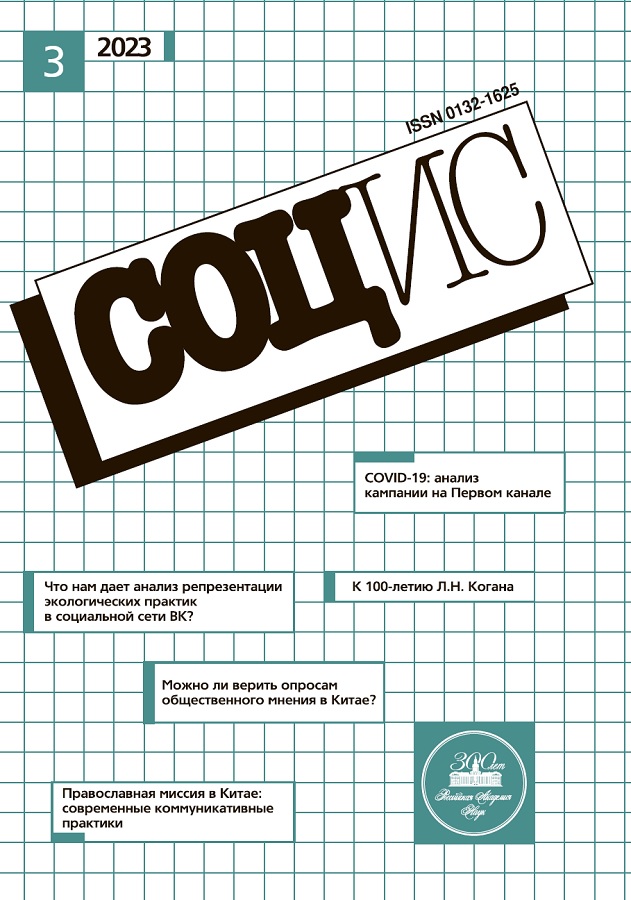“Human Resources” as a Category of Qualitative Sociology
- Authors: Ilyin V.I.1
-
Affiliations:
- St.-Petersburg university
- Issue: No 3 (2023)
- Pages: 32-41
- Section: Articles
- URL: https://ruspoj.com/0132-1625/article/view/661595
- DOI: https://doi.org/10.31857/S013216250025139-5
- ID: 661595
Cite item
Abstract
The purpose of this article is to adapt the categories of human resources and capital in relation to the logic of qualitative sociology, which turns to existential everyday life. The starting point of the analysis in it is a person striving for his social self-realization in the context of available objective opportunities that have the form of chances: they can be used or missed in different ways. The situation of choice includes both an objective component and the subjectivity of the acting individual (conscious needs and interests, tastes, value orientations, moods, feelings, volitional characteristics, etc.). As a result, different individuals use the same human resources (chances) in different ways. The subject of the study shifts from the classic question "Who has what?" to the process of turning abstract possibilities into the reality of an individual social situation. Incorporated resources are a continuum, each element of which can become a reality as a result of choice (including imposed) and achievement: (1) abstract potential, the implementation of which depends on a variety of conditions; (2) consumer human resources; (3) labor force; (4) human capital as a resource that creates surplus value in the course of market turnover. In some cases, the resource is sold as labor, and the created surplus product is appropriated by the employer. In others, the individual acts as an entrepreneur, independently bringing his incorporated resources to the market and appropriating the resulting surplus value. Human resources represent only the chances of acquiring one or another real form. The metamorphoses of human resources occur to a significant extent in the context of the market situation. Its main elements are (1) individual potential, (2) availability of vacant jobs, (3) agency of a potential employee and employer, (4) definition of the market situation by its participants.
Full Text
References
- Абрамов Р. На подхвате у алгоритма, или истории поденщика платформенного капитализма // Интер. 2022. Т. 14. №3. С. 35–54.
- Бауман З. Текучая современность / Пер. с англ. С.А. Комарова; под ред. Ю.В. Асочакова. СПб.: Питер, 2008.
- Бурдье П. Формы капитала // Экономическая социология. 2005. Т. 3. № 5. С. 60–74. URL: https://ecsoc.hse.ru/data/2011/12/08/1208205039/ecsoc_t3_n5.pdf (дата обращения:11.02.2023).
- Ильин В.И. Феномен поля: от метафоры к научной категории // Рубеж. 2003. Вып. 18. С. 29–49.
- Квале С. Исследовательское интервью. М: Смысл, 2003.
- Константиновский Д.Л., Вознесенская Е.Д., Чередниченко Г.А. Интернационализация образования и российская молодежь: открытия, обретения, результативность. М.: ИС РАН, 2008.
- Маркс К. Капитал. Критика политической экономии. Т. I. // Маркс К., Энгельс Ф. Избр. соч. Т. 7. М.: Полит. лит-ра, 1987.
- Пинчук О.В. «Партизанщина» на позднесоветском заводе через призму драматической социологии Андрея Алексеева // Интер. 2022. Т. 14. №3. С. 78–97.
- Пинчук О. Сбои и поломки. Этнографическое исследование труда фабричных рабочих: включенное наблюдение на рабочем месте. М.: ФПСИ «Хамовники»; Common Place, 2021.
- Позняков В.П. Предприимчивость // Энциклопедия гуманитарных наук. 2012. № 3. С. 245–246.
- Попов Д.С. Человеческий капитал в России: точность измерения и ограничения подхода // Социологические исследования. 2020. № 11. С. 27–38.
- Практики управления персоналом на современных российских предприятиях / Под ред. В.И. Кабалиной. М.: ИСИТО, 2005.
- Радаев В.В. Понятие капитала, формы капиталов и их конвертация // Общественные науки и современность. 2003. № 2. С. 5–16.
- Радаев В.В. Экономическая социология. М.: ГУ ВШЭ, 2005.
- Росс Л., Нисбетт Р. Человек и ситуация. М: Аспект Пресс, 2000.
- Сартр Ж.-П. Экзистенциализм — это гуманизм // Сумерки богов / Сост. и общ. ред. А.А. Яковлева. М.: Политиздат, 1989. C. 319–344.
- Старовойтенко А.Д. (Де)субъективация работников в пространстве склада маркетплейса: цифровой диктат или индустриальный базар // Интер. 2022. Т. 14. №3. С. 55–77.
- Тихонова Н.Е. Ресурсный подход как новая теоретическая парадигма в стратификационных исследованиях // Экономическая социология. 2006. Т. 7. № 3. С. 11–26.
- Шкаратан О.И., Бондаренко В.А., Крельберг Ю.М., Сергеев Н.В. Социальное расслоение и его воспроизводство в современной России. М.: ГУ–ВШЭ, 2003.
- Штомпка П. В фокусе внимания повседневная жизнь. Новый поворот в социологии // Социологические исследования. 2009. № 8. C. 3–13.
- Becker G.S. Human Capital. N.Y.: Columbia University Press, 1964.
- Becker G.S. Foreword // T.W. Schultz. Human Resources. N.Y.: National Bureau of Economic Research, 1972.
- Bottone G., V. Sena. Human Capital: Theoretical and Empirical Insights // The American Journal of Economics and Sociology. 2011. Vol. 70. No. 2. Social, Methods, and Microeconomics: Contributions to Doing Economics Better. P. 401–423.
- Holzer Harry J. What Employers Want: Job Prospects for Less Educated Workers. N.Y.: Russell Sage Foundation, 1996.
- Mincer J. Investment in Human Capital and Personal Income Distribution // Journal of Political Economy. 1958. Vol. 66. P. 281–302.
- OECD. Human Capital Investment: An International Comparison. OECD,1998.
- Sawyer D.O. Review Essay: Social Roles and Economic Firms: The Sociology of Human Capital // American Journal of Sociology. 1978. Vol. 83. No. 5. P. 1259–1270.
- Schultz T.W. Investment in human capital // American Economic Review. 1961. Vol. 51 (1). P. 1–17.
- Schultz T.W. Нuman Resources. N.Y.: National Bureau of Economic Research, 1972.
- Sorensen A.B. Toward a Sounder Basis for Class Analysis // American Journal of Sociology. 2000. Vol. 105. No. 6 (May). P. 1523–1558.
- Thomas W.I., Thomas D.S. The Child in America: Behavior Problems and Programs. N.Y.: A.A. Knopf, 1928.
- Tomaskovic‐Devey D., Thomas M., Johnson K. Race and the Accumulation of Human Capital across the Career: A Theoretical Model and Fixed‐Effects Application // American Journal of Sociology. 2005. Vol. 111. No. 1. P. 58–89.
- Wilson F., Tienda M., Wu L. Race and Unemployment: Labor Market Experience of Black and White Men, 1978–1988 // Work and Occupations. 1995. Vol. 22: P. 245–270.
Supplementary files










